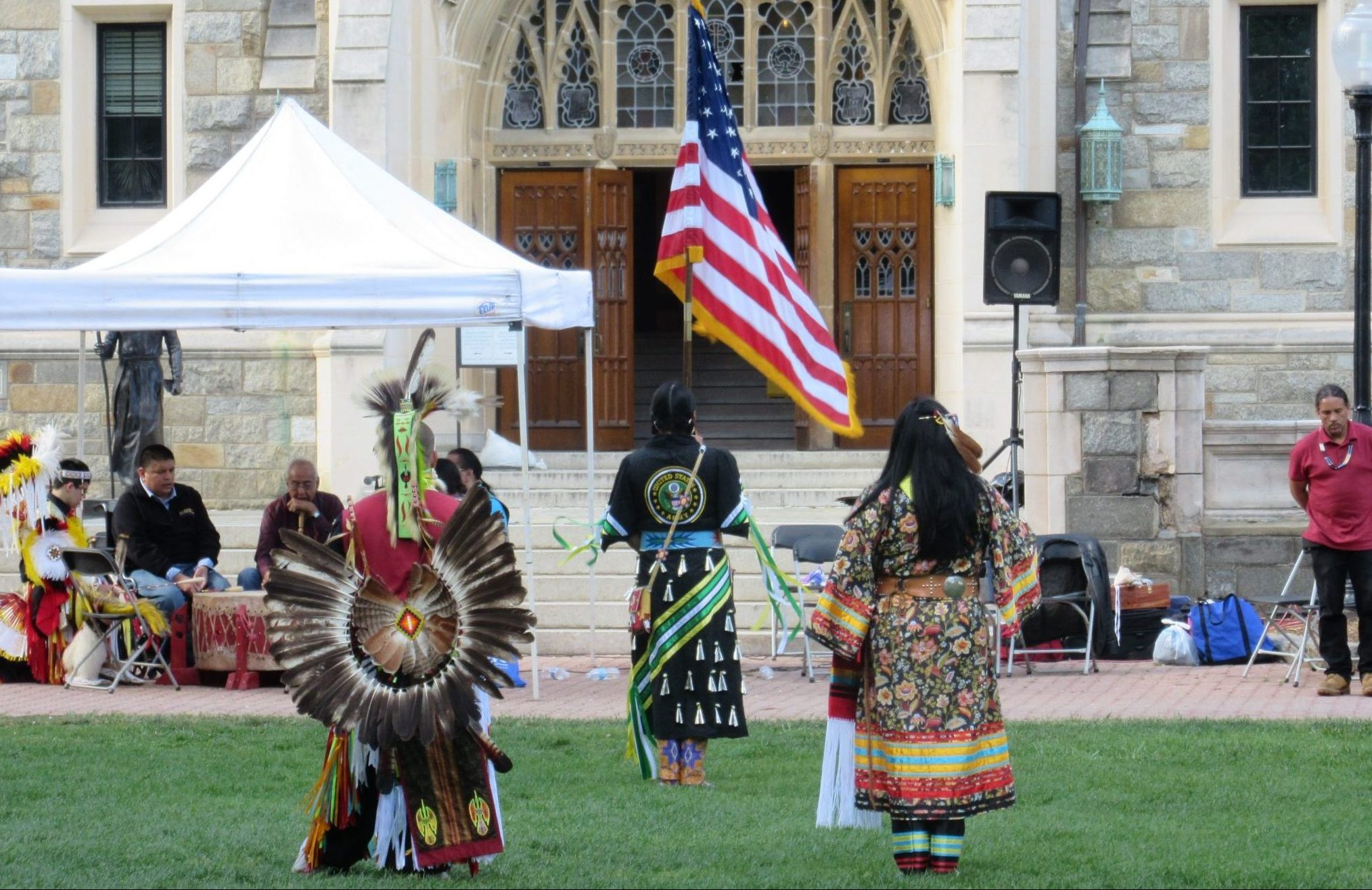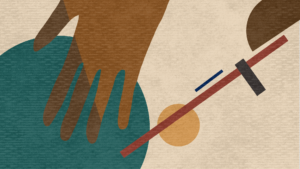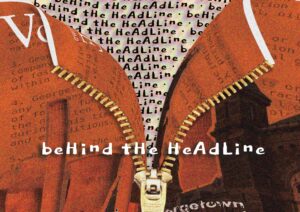At a presentation on Oct. 12, “Indigenous Resistance Across Borders: Political Education and Storytelling,” many of the people gathered at Casa Latina were familiar with each other. Kelsey Lawson (SFS ’19), Yasmin Zuch (NHS ’20), and Jesse Gibson (SFS ’19) stood off to the side: part of the group, but not quite. The three settled down on a couch and waited for the event to begin, hoping that it would be a success. For Lawson, Zuch, and Gibson, this was not just an opportunity to delve deeper into the history of indigenous peoples. They hoped it would be the start of a critical year for the Native American Student Council.
In 2012, two students rebranded the former American Indian and Alaska Native Association as the Native American Student Council (NASC). They opened the club to those without a Native American background in an effort to bring in more people dedicated to the interests of the Native American community. Membership has fluctuated over the years, and along with a few non-native members, there are now only three Native American students in the club: the aforementioned trio of Lawson, who is part Siberian Yupik; Zuch, a registered Navajo; and Gibson, who is half Choctaw with Chickasaw and Coushatta ancestry.
One of NASC’s main purposes is to connect Native American students at Georgetown. “We want to reach out to other Native American students on campus and let them know that we are here and there is this organization where they can have a cultural space,” Gibson said. Gibson is the former president of NASC, and now represents the group in the Student of Color Alliance, the umbrella organization for groups serving students of color at Georgetown.
But even though NASC is the only organization on campus dedicated to the American Indian and Alaska Native population, the group’s membership has dwindled as a result of its limited visibility on campus.
“I hope as we put on events we can garner support from the general student population,” said Zuch, the club’s vice president. “I know my freshman year, I didn’t even know this existed. I’m sure there are countless numbers of Native Americans in the student body who we haven’t gotten into contact with because our outreach is so small.”
Jade Ferguson (SFS ’22), a freshman of Cherokee descent, is not a member of NASC. When she arrived on campus, she wanted to join a Native American student group, but did not know how to find one. “I didn’t find out this was a thing until recently,” she said. “I don’t know how to contact them yet, and I haven’t met any of the people in the club.”
Zuch agreed that NASC can be hard for students to find, which may make it seem as though there is no Native American presence on campus. She believes this perception stems partly from many Americans’ lack of interaction with the modern Native American experience. “I have come across quite a few misconceptions since I’ve been on the East Coast that I would not have expected,” she said. “I have had people ask if I still live in a tepee, and they are surprised at how modernized some of the tribes are. I have encountered a couple people who had never met a Native American before.”
Zuch is from Flagstaff, Arizona, where Native Americans make up a share of the population more than 10 times greater than they do nationally, according to the U.S. Census Bureau. But at Georgetown, Zuch said, the Native American community is sparse. “I went from living an hour away from the reservation to here, where there is nobody,” she said. In fact, Georgetown’s 2017-2018 Common Data Set shows no self-reported American Indian or Alaska Native undergraduate students. This data is based on an optional survey, meaning students can choose not to report their race or ethnicity.
This lack of representation extends to faculty as well as students. “I am only aware of one faculty member who is Native American on campus. Typically, I will be the only Native American student in the classroom,” Zuch said.
The members of NASC believe this lack of Native American presence on campus creates an even larger need for their organization. Gibson said NASC helps students like him “try to fortify those ties to our culture in this most formative part of our lives.”
That is especially important for Gibson, who is from Oklahoma, the state with the second highest Native American population in the United States. When he arrived in a city over 1,000 miles away from home, he felt separated from the culture he grew up with.
“When I got here, I went through a huge culture shock,” Gibson said. “I felt like I was identifying only with my white side because I wasn’t able to be my native side here.”
Lawson, the club’s president, described the importance of interacting with those who share her heritage. “I think it can be very healing to discuss the shared issues that affect our communities,” she said. “For me personally, I’ve always felt kind of isolated and alone with my identity, so getting to know other people who have felt the same way or are passionate about the same things, there is strength in that.”
NASC’s faculty advisor, Bette Jacobs, has been supporting Native American students since she joined Georgetown in 2000, including as a faculty advisor for the group NASC succeeded and as part of the Indigenous Studies Working Group. Jacobs, an enrolled member in the Cherokee nation with a Shoshone background, also co-teaches a class about Indigenous People’s Conflict and Resolution. “Representation should stay alive,” she said. “It isn’t always a good history, but it is a shared history.”
NASC is part of a wider community of cultural groups on campus that are represented as a whole by the Student of Color Alliance. Many students involved in groups under the organization see their membership as a way to come together with others from similar backgrounds and find acceptance on campus and for themselves.
Zhanelyn Joy Cacho (COL ’22), the Club Filipino representative to the Student of Color Alliance, explained that she has struggled to maintain her Filipino identity at Georgetown. “There were certain words that I cut out in my vocabulary and certain mannerisms I would do back home that I didn’t feel that I should do here,” Cacho wrote in an email to the Voice.
But the student organizations she joined showed her that her culture was essential to making the university feel more like home.
“Once I joined cultural clubs like Club Hawai’i and Club Filipino, I realized how crucial it is to hold on to your culture more than anything,” Cacho wrote. “It’s so important to dress yourself with the strength and pride of your ancestors.”
For international students like Alison Hsu (MSB ’19), who is part of the Taiwanese American Student Association (TASA), turning to a cultural club can ease the burden of fitting in on campus. “In a way, [TASA] strengthens my sense of belonging in Georgetown,” Hsu wrote in a message to the Voice. “I often find this feeling mutual even with members who are not from Taiwan but nevertheless felt connected with the Taiwanese culture.”
TASA and Club Filipino both have a larger pool of students to draw from, which has helped support their robust memberships, lending stability to their missions. NASC has found itself struggling to do the same.
“As it is right now, we are having problems having enough people in the organization to have access to funds,” Zuch said. Student organizations are required to have 12 members to be officially recognized by the university. “It is frustrating to know that something as vital as our financial need is in jeopardy just because we don’t have enough people.”
As a senior and the club’s president, Lawson wants to make sure NASC survives and thrives past her tenure on campus. “I would like to be confident that it has a future and it will be around.” NASC views the rest of this year as a stepping stone to a bigger role on campus.
Their largest event is an annual powwow in the spring. The event, which reached its sixth year this spring, features Native American dancers, musicians, and vendors. Participants hail from D.C. and the greater Metro area, but also come from as far as Pennsylvania each year. The central location of the event, held on Copley Lawn, helps draw awareness and interest from people on campus. NASC hopes it will continue to be widely attended, even if people just stop to see what all the commotion is about.
But Zuch said that she wants NASC to grow beyond this yearly event. The club has taken stands on issues like the proposed pipeline at Standing Rock and renaming Columbus Day to Indigenous Peoples Day. Georgetown now labels the weekend “Mid-semester Holiday.”
***
From their view on the couch, Lawson, Zuch, and Gibson watched the discussion, which they co-hosted with Casa Latina, unfold. They observed members of both the Black House and Casa Latina discuss and debate indigenous peoples’ problems all over the world. They interjected with their own experiences and listened to stories similar to theirs. They heard words of solidarity from students whose lives had been vastly different, yet, in a way, the same. They received encouragement about the challenges they face and are reminded that the work they are doing matters. The three left believing that it would not be the last partnership between the cultural groups, but the first of many.
“Casa Latina and the Black House are amazing allies for us,” Gibson said. “They have the numbers and resources to have the strong community that we would like to model ourselves after someday. They are able to spread the cultural influence and help us have a medium to spread our culture.”
Members of the Black House and Casa Latina are excited to be a part of these plans and are rooting for their successful future. “I hope they continue to grow in visibility on campus, and gain more traction and support for their activism,” wrote Chelsea Hernandez (SFS ’20), a member of Casa Latina, in a statement to the Voice.
Beyond working with other student groups, Zuch wants to take on admissions issues for Native American students.
“I would like to see a push in the admissions process for Native American applicants,” she said. “Talking to other members of NASC, they’ve agreed that other schools we applied to, we found support in the admissions process.”
In at least one case, this support came in the form of outreach from the Native American student association on that campus: Lawson said that the Native American Association at Stanford reached out to her during the application process. “As for Georgetown,” Lawson said, “we have all come to the conclusion that we haven’t seen anything like that.”
A university spokesperson wrote in an email to the Voice that Georgetown tries to bring in exemplary students from all backgrounds. “Georgetown is committed to multicultural recruitment and supports prospective students from diverse backgrounds and geographic regions, including Native American students, throughout the recruitment and application process,” they wrote. “By engaging with current students, alumni and staff serving diverse communities the Office of Undergraduate Admissions continually seeks to enhance the recruitment of students from underrepresented backgrounds.”
Without the resources for a strong recruitment effort, the club’s path forward is far from clear. NASC has momentum with student leaders like Lawson, Zuch, and Gibson, yet they know helping the club continue to thrive in the future will not be easy.
“One thing about student groups: They come and go,” Jacobs said. “When you have a small denominator to begin with and there are people who exit, there isn’t a lot of succession planning.”
But Lawson, Zuch, and Gibson are not deterred by these challenges. “We are working on indigenous resilience and being more active in the Georgetown community,” Lawson said. “I think people will be receptive. I have faith in it. I have hope.”




